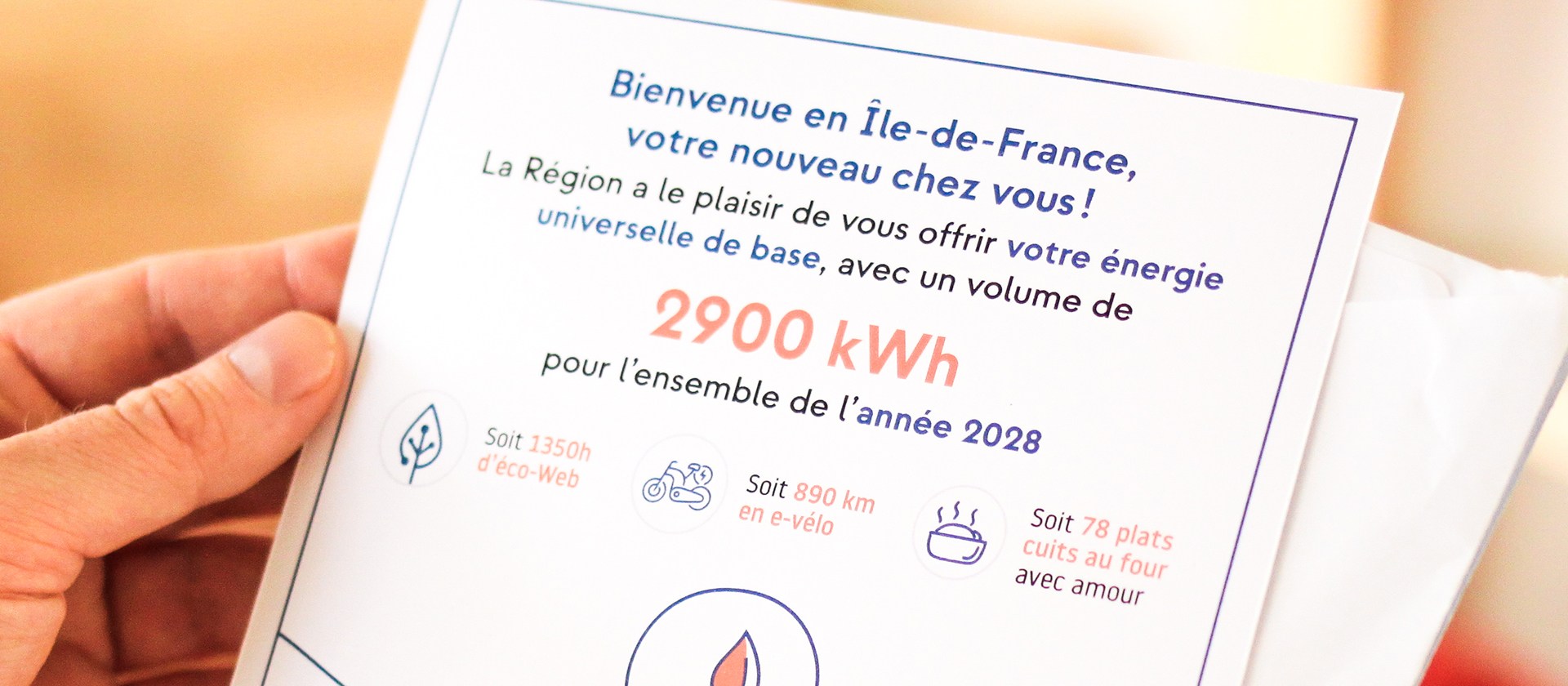
The imaginaries of energy sobriety
The imaginaries of energy sobriety: allies and adversaries of a necessary transition
What are the dominant, emerging, and divergent representations that shape our vision of energy sobriety? Which imaginaries should be explored to uncover the levers of a desirable and sustainable energy sobriety?
This is the question posed by the Île-de-France Regional Energy and Climate Agency (AREC) in its effort to create a shared culture and collectively envision a chosen, fair, and innovative form of sobriety for the Paris region.
In collaboration with our partners from Auxilia-Chronos, we conducted a study that blends sociology with speculation to provide projection tools aimed at mobilising elected officials, services, and operational stakeholders on the topic of applied sobriety. However, this collective mobilisation cannot ignore the importance of social imaginaries in shaping what is perceived as “desirable” energy sobriety.
Initially, the study aimed to identify, analyse, and narrate various imaginaries of energy sobriety in order to question their influence. Individual and collective behaviours, technical as well as social innovations, the influence of beliefs and cultures, modes of governance and resistance – different facets of energy sobriety were examined, with a central focus on representations and values, whether shared or not.
To this end, the analysis of contributions from 14 workshops led by the AREC, along with interviews with key stakeholders and experts on energy, helped to sketch and challenge an initial typology of imaginaries for sobriety.

The success of disinfluencers
Influencers who have dominated social networks have been the symbol of a society of hyperconnection and hyperconsumption, brought to its peak. The shift driven by the Great Renunciation sees the emergence of a counter-movement: the reign of disinfluencers.
These media personalities subvert the codes of buzz-making to narrate and embody success stories of sobriety. Their ‘simple living’ lifestyles are carefully displayed and staged to encourage their audience to detach from the fantasy of social climbing and reject excessive consumption.
On a more positive note, disinfluencers promote the DIY spirit, as well as the praise of a certain aesthetic of the repaired and patched-up, which has become the new standard of ‘beauty’, especially in fashion.
The latest trend promoted by disinfluencers consists of dismantling parties, the famous D-Parties. These gatherings aim to dismantle – even demolish – elements that were identified by citizen disinnovation conventions as subject to renunciation. Notably, iconic D-Parties are held for the participatory de-asphalting of school playgrounds.
However, other controversial and radical disinfluencers go further, publicly naming those who resist renunciation. During live sessions, these renunciation advocates invite their followers to engage in virtuous sabotage of the property and activities of these targets in order to force their transition toward greater sobriety.
Disinfluencers are the spearhead of a broader movement spreading across businesses in the region: demarketing. More than a trend, this term encompasses all strategies aimed at discouraging certain behaviours and reducing the appeal or demand for certain products and activities
Except from
The Great Renunciation

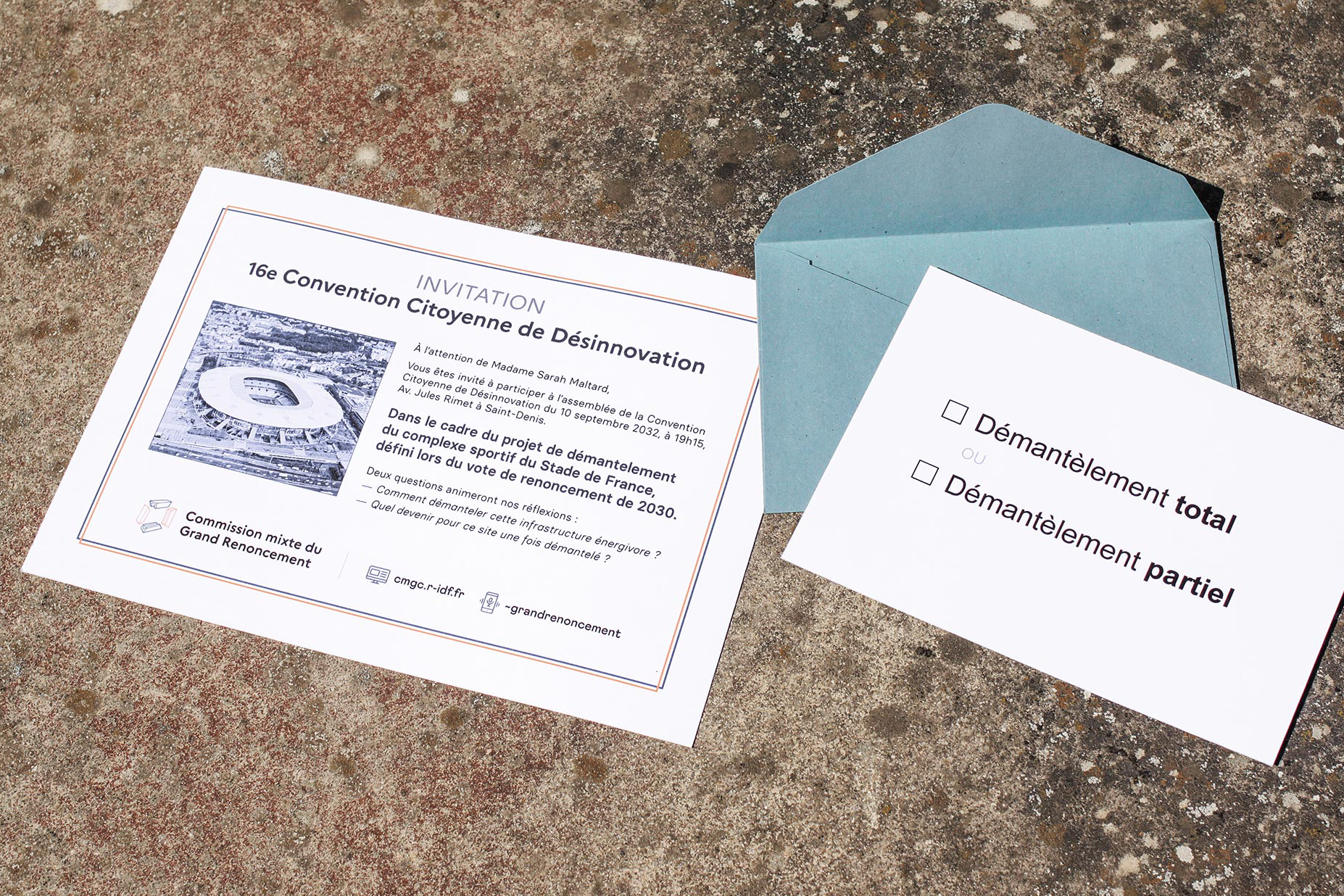
↑ The Great Renunciation
The invitation to participate in a citizen convention on disinnovation, as part of the renouncement and dismantling of the Stade de France sports complex.

Popular sousveillance
Across the Île-de-France region, as in the rest of France, the principle of ‘sousveillance’ prevails: the most disadvantaged classes have the right to monitor and control the behaviours of the wealthier classes, which are also known to be the most energy-consuming. This is therefore bottom-up surveillance, conducted by those in precarious situations on a daily basis. The constant pressure of millions of eyes is usually enough to correct resource consumption deemed excessive.
In practice, popular dissuasion strategies can take various forms to increase bottom-up pressure: name and shame is the mildest, the demonisation of ostentatious behaviours has become the norm, and demands for the seizure of assets to curb overconsumption have become a routine, institutionalised civic action.
An exemplary level of energy sobriety is also demanded of elites: any mandate of a private-sector leader, an elected official, or a public administrator can be revoked if their behaviour does not align with self-limitation goals. Political or economic inconsistencies, financial waste, or energy excesses are seen as marks of hypocrisy – or worse, as signs of corruption.
Except from
Self-limited sousveillance

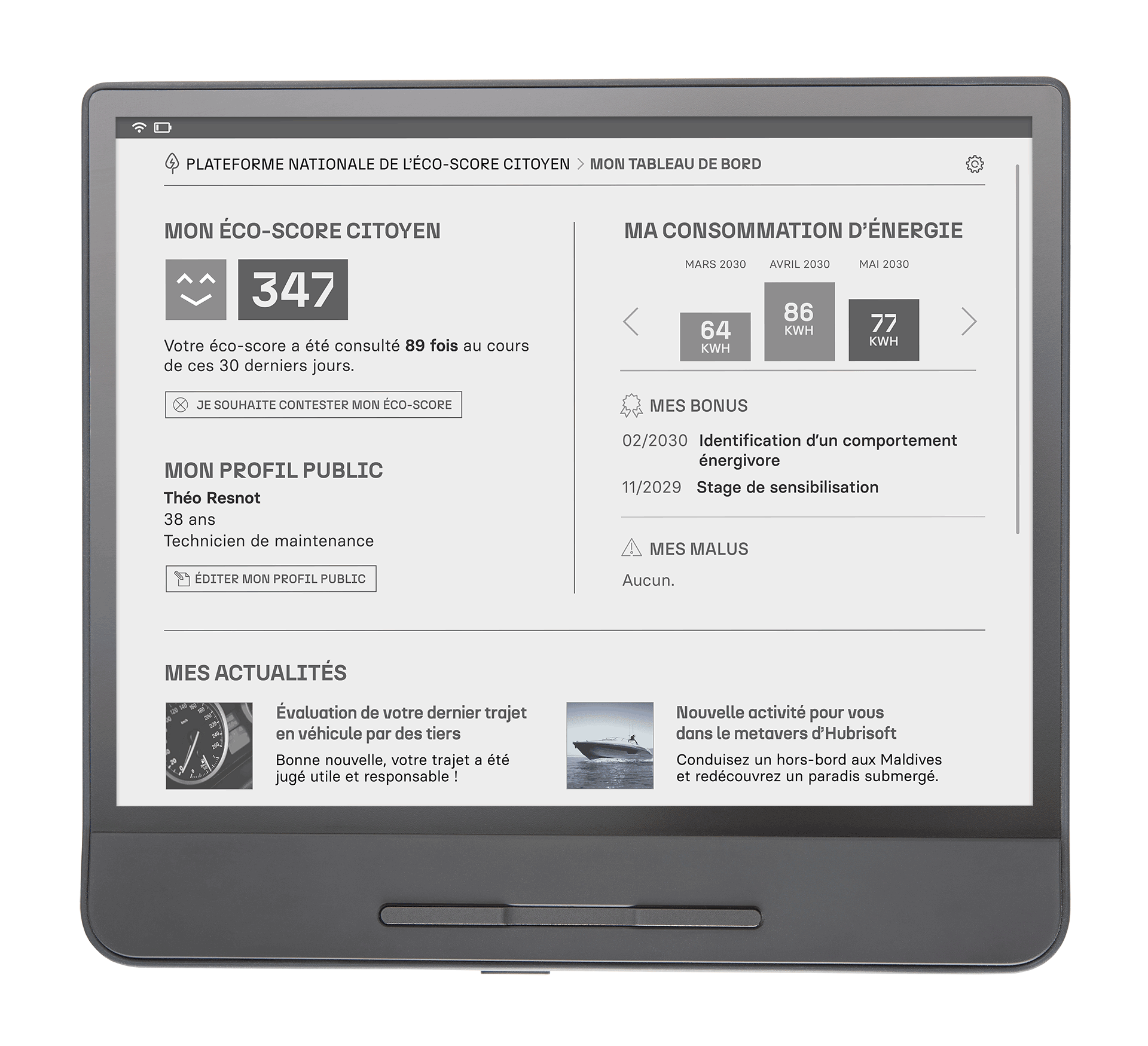
↑ Self-limited sousveillance
The dashboard of an eco-score for a resident of Île-de-France.

Experts in sobriety
What if immigration, particularly that of political and climate refugees, were an unexpected opportunity for a ‘transfer of strategic knowledge in energy resilience’?
This is the stance taken by the Regional Department of Energy Resilience Research (DRRRE), which draws on the knowledge of refugees from Sub-Saharan Africa, the Middle East, and South/Southeast Asia.
Exiles have survived with little or no electricity or belongings during their journey, as in their past daily lives. This experience – often traumatic – has been valorised, allowing them to integrate more easily into society in Île-de-France. Refugees are considered ‘experts in sobriety’; specialists capable of assessing our energy dependency based on their lived experience, and advising both private and public actors in their frugal transition
Extract from
Energy Justice

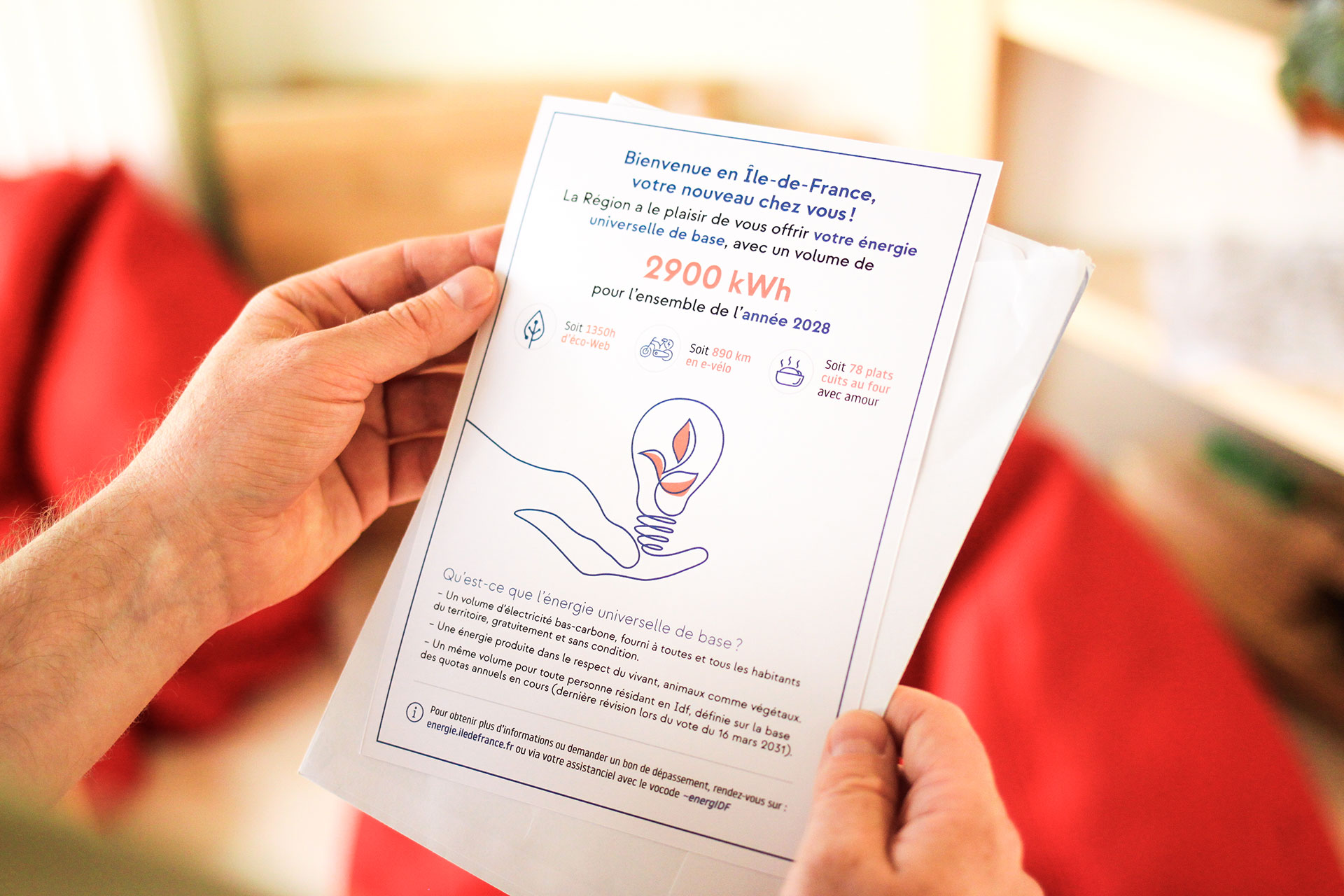
↑ Energy justice
The flyer accompanying the launch of universal basic energy rights, offered to a new resident moving to Île-de-France.
The second phase of the study drew on this “raw material” made of imaginaries to develop three speculative scenarios. Anchored between 2028 and 2032, they offer a vision of daily life in Île-de-France depending on which energy sobriety imaginary takes hold:
- The Great Renunciation, viewed through the lens of degrowth and repair imaginaries.
- Self-Limited Sousveillance, seen through the imaginaries of techno-solutionism and green growth.
- Energy Justice, approached through the lens of social justice and resilience imaginaries.
The narrative and prototyping of possible futures for energy sobriety were complemented by a debate on these perspectives during a participatory workshop in May 2022.
Based on the scenarios deemed preferable during this debate, we then developed Imaginairgy, a playful toolkit to equip local stakeholders and disseminate the next steps of the AREC initiative.
A true extension of the study’s work, Imaginairgy offers, through a creative and reflective speculative workshop, the opportunity to revisit the scenarios and related imaginairies to invent the measures, solutions, and other initiatives that helped achieve an energy sobriety that would be accepted and celebrated in each of these futures. More practically, the second part of the tool grounds these speculative fictions in the present, identifying manifesto actions to be implemented today for greater sobriety, through initiatives that have a tangible impact and foster shared imaginaries.
This exploration therefore bets on bottom-up appropriation rather than top-down prescriptions. More than mere recommendations, we sought to develop this study as a versatile tool that local authorities and regional stakeholders – starting with the AREC – can use, whether to imagine, critique, or materialise their own narrative of energy sobriety, or to reflect on the levers to activate and barriers to remove, as well as the regional impulses to develop in order to embark on a lasting transition.
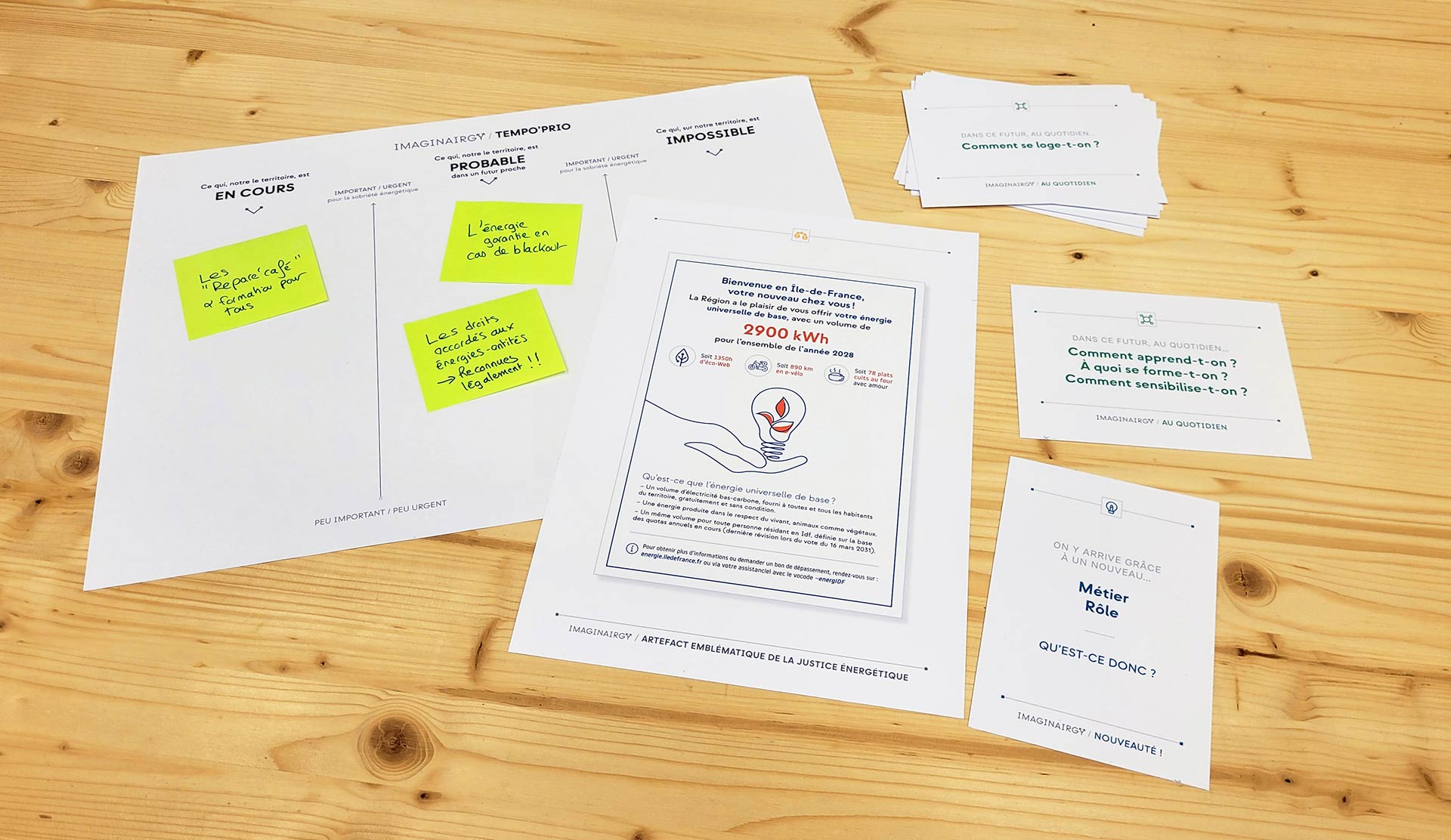
↑ The Imaginairgy kit reopens the three fictions, suggesting that actors complete the ‘last mile of speculation’ by reflecting on how each imaginary transforms their activities or local areas.
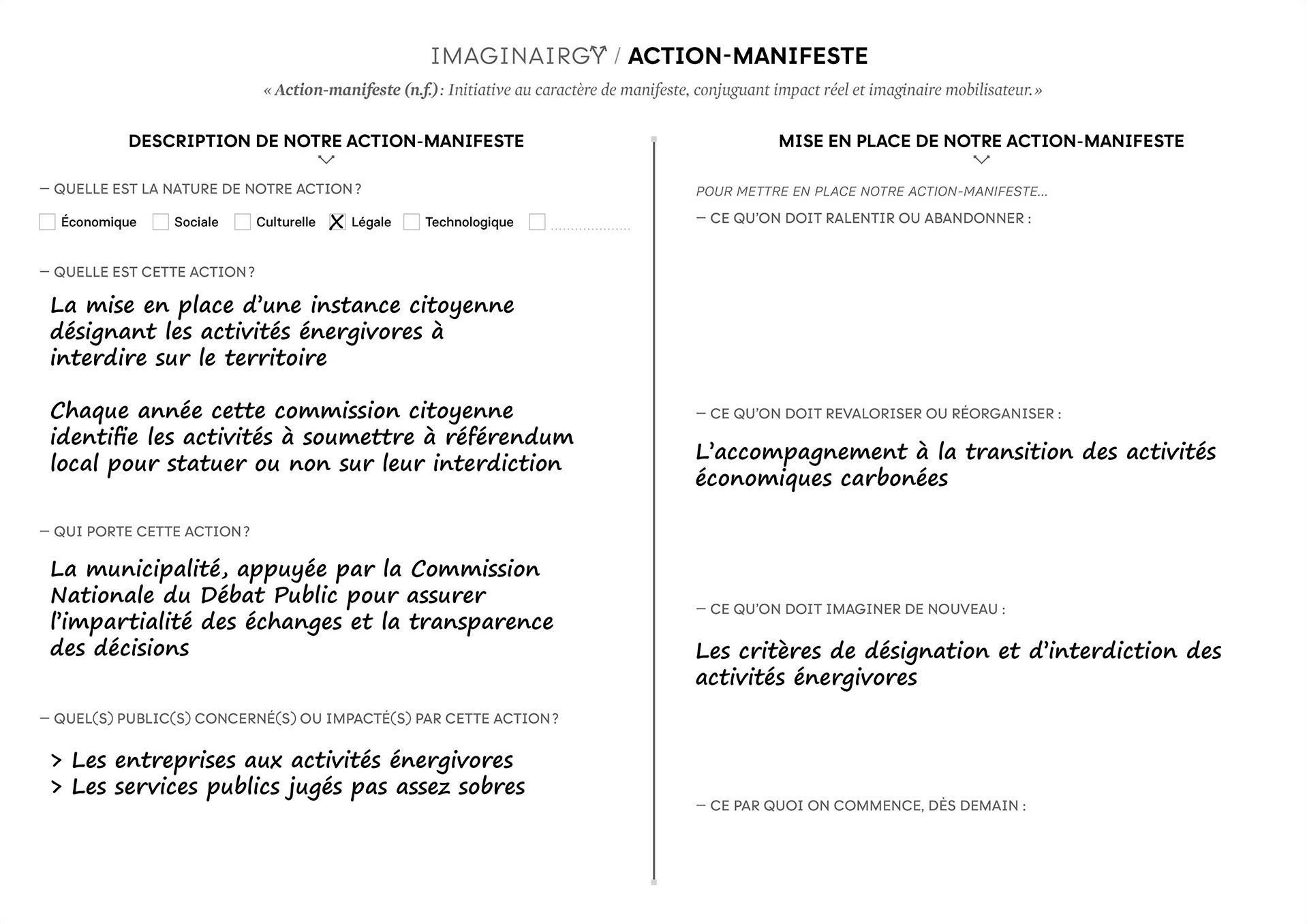
↑ The manifesto action sheets help formalise imaginaries-based levers applicable to the energy sobriety of local governments in Île-de-France.
